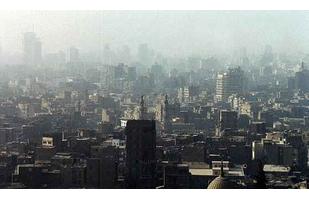The term "black cloud" has become widely used by Egyptians to describe the tiny particles of pollution in the air over the capital. For ten years now, from October to December, the cloud has appeared over Cairo's cityscape from dusk until dawn.
 Farmers have been the traditional scapegoats for the phenomenon, due mainly to their practice of burning rice straw at the outset of the rice-harvesting season. The Egyptian Environment Affairs Agency, however, announced this week that farmers were only partially to blame.
Farmers have been the traditional scapegoats for the phenomenon, due mainly to their practice of burning rice straw at the outset of the rice-harvesting season. The Egyptian Environment Affairs Agency, however, announced this week that farmers were only partially to blame.
“Intensive burning of rice straw, car fumes and industrial and solid waste all play a role in causing the black cloud," Environment Minister Maged George said on Monday.
“Burning rice straw accounts for six per cent of Egypt's air pollution throughout the year," the minister explained. "During the rice harvesting season, however, this figure jumps to 45 per cent."
Automobile fumes represent another major cause of the black cloud.
Cairo is internationally recognized as one of the worst cities in terms of heavy traffic, with around 4.3 million vehicles traversing its streets daily. More than one fifth of those cars are aging clunkers -- many more than three decades old.
The cloud can also be partly attributed to industrial pollution, for which state-owned factories in the industrial districts of Helwan and Shubra el-Kheima account for more than 50 per cent.
Cairo and Giza have consistently been the most effected by air pollution due to their topography, situated on the lowlands along the Nile River from Shubra in the north to Helwan in the south. It is here that air pollutants tend to accumulate, forming a grimy layer that does not exceed 25 meters in height.
"We began working on programs to recycle hay four or five years ago," explained George. "A number of private companies took part, especially in Qalyoubeya, Sharqeya, Gharbeya and Daqahleya."
One of these projects was the Community Environment Action Project (CENACT), undertaken in collaboration with the Canadian International Development Agency and the EEAA, which launched five years ago in Ismailia and Minya. Though originally scheduled to conclude in 2008, the project is now expected to run until December of this year.
“Our target was solid and agricultural waste management in general, with a focus on the hay burning," program field manager Hany Tawfeeq said.
CENACT comprises seven other sub-projects aimed at recycling rice straw and other agricultural wastes into compost.
“We cooperated with NGOs and gave them a tractor, a trailer and a chopper for this purpose," said Tawfeeq. “The objective is to enable NGOs to make money and raise awareness among farmers of the dangers of rice-straw burning."
Through the program, he explained, farmers can save between LE70 and LE100 per ton of manure, which they can obtain from agricultural societies in return for surplus straw.
One of the NGOs to benefit from the CENACT project was that of Abu Halifa in Ismailia.
“The process of transforming straw into compost has three forms," said Ahmad Ibrahim, consultant for Abu Halifa. "The first is to transform the hay into fodder; the second is to recycle it into compost; and it can also be used by farmers and housewives to culture vegetables."
“The project is profitable for both NGOs and farmers," added Ibrahim.
The environment minister has said that the total amount of rice straw burnt this year had been reduced to 1.7 per cent, down from 2.2 per cent last year. He went on to point out that farmers received LE45 per ton of straw after handing it over to designated gathering centers.
“There are 185 equipped centers in the Delta," he noted. "Meanwhile, we're continuing to encourage private companies to play a greater role in converting burning straw into energy."
In the meantime, though, the "black cloud" appears set to continue plaguing the capital and its inhabitants.



